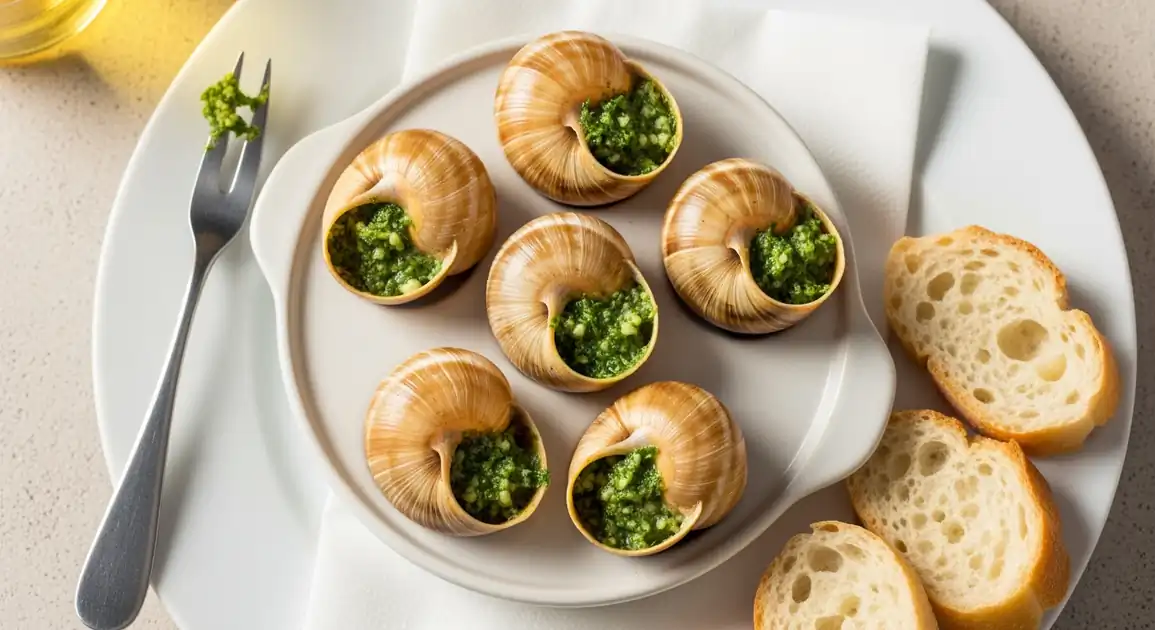Burgundy Snails
Escargots de Bourgogne

Description
Throughout France, Escargots de Bourgogne represent a quintessential appetizer in traditional French cuisine. While originating in Burgundy, this preparation has become a national dish found in bistros and brasseries nationwide. Enjoying properly prepared escargots offers insight into French culinary tradition, with regional variations appearing in different parts of the country.
Dietary Information
Serving information
Serving style
Served in specialized escargot plates with individual depressions for each shell, accompanied by special tongs to hold the hot shell and a small two-pronged fork to extract the meat. Always accompanied by bread for soaking up the butter.
Quick facts
Lunch service typically 12 PM - 2:30 PM, dinner service 7 PM - 10:30 PM, with regional variations. Many restaurants close between lunch and dinner service.
Safety Tips
What to Look For
-
Piping hot, bubbling butter
Properly prepared escargots should be served extremely hot with the butter actively bubbling. This indicates they've been properly heated through, ensuring food safety.
-
Reputable, established restaurants
Choose bistros and brasseries known for traditional French cuisine rather than tourist-oriented establishments. Quality restaurants take proper care in the extensive preparation process.
-
Proper aroma of garlic and herbs
The dish should have a clean, herbaceous smell dominated by garlic, parsley, and butter. Any strong ammonia or spoiled odors indicate poor quality or improper preparation.
-
Specialized escargot plates and utensils
Restaurants serving authentic escargots will use proper equipment, which often correlates with attention to traditional preparation methods.
What to avoid
-
Cold or merely warm escargots
Escargots must be thoroughly heated. Cold spots or lukewarm butter could indicate improper heating, which is both a safety and quality issue.
-
Pre-prepared escargots sitting under heat lamps
Quality escargots should be finished to order. Avoid places where you can see them sitting prepared beforehand.
-
Extremely cheap escargots at tourist-focused restaurants
Proper escargot preparation is time-consuming and ingredient-intensive. Unusually low prices might indicate corner-cutting in the preparation process or quality of ingredients.
-
Strong fishy or muddy odors
Quality escargots should never smell overly pungent. Off-putting odors suggest poor quality snails or inadequate purging/cleaning during preparation.
Price information
Price range
Budget tips
- Lunch menus (formules) often include escargots as a starter at a better value than ordering à la carte.
- A half-dozen (6) escargots is typically 8-12 EUR, while a dozen (12) ranges from 16-18 EUR.
- Neighborhood bistros away from tourist centers typically offer better value than restaurants in prime locations.
- Look for 'happy hour' promotions at brasseries, which sometimes include discounted appetizers.
Value indicators
- Specialized escargot dishes and proper utensils provided.
- House-made garlic-herb butter rather than pre-prepared.
- Proper size and proportion of the snails to their shells.
- Served piping hot directly from the broiler.
- Quality bread served alongside for sauce-sopping.
Where to Find This Dish
Traditional Bistros
Authentic French bistros nationwide serve classic escargots as a starter.
Neighborhood bistros, Burgundian specialty restaurants
Dinner (7 PM - 10 PM)
Brasseries
These larger, often more bustling establishments frequently feature escargots on their extensive menus.
Historic brasseries, Train station adjacent dining
Lunch (12 PM - 2 PM), Dinner (7 PM - 11 PM)
Burgundy Region
Restaurants in this region take particular pride in their escargot preparations, often using locally sourced snails.
Dijon, Beaune
Dinner (7 PM - 9:30 PM)
Vendor Tips
- Ask if the garlic-herb butter is house-made for an indication of quality.
- Check if the restaurant uses wild or farmed Burgundy snails (Helix pomatia) for authenticity.
- In tourist areas, restaurants with menus exclusively in English often serve lower quality escargots.
How to Order
Regional Variations
-
Traditional Burgundy Style
(Escargots à la Bourguignonne)
The classic preparation with garlic-parsley butter, served in the shell. This is what most people expect when ordering escargots.
-
Nut Butter Escargots
(Escargots au Beurre de Noix)
A variation using walnut butter instead of or in addition to herb butter, adding a nutty complexity.
-
Champagne Sauce Escargots
(Escargots à la Sauce au Champagne)
A more luxurious variation where the snails are served with a champagne-based sauce, often featuring cream and sometimes truffle.
-
Croquettes of Escargots
(Croquettes d'Escargots)
A modern interpretation where the snails are incorporated into croquettes, often with herbs and sometimes cheese, then breaded and fried.
-
Escargots in Puff Pastry
(Escargots en Feuilleté)
Snails removed from their shells and baked inside puff pastry, typically with the traditional garlic-herb butter.
Cultural context
History
The consumption of snails dates back to prehistoric times, but the Burgundian preparation became refined during the 19th century. The tradition gained prominence in French gastronomy, with escargots becoming a symbol of French cuisine worldwide by the 20th century. Originally a peasant food in Burgundy, where wild snails were abundant after rainfall, the dish evolved into haute cuisine through the addition of butter, garlic, and herbs. The specific species used, Helix pomatia (Roman or Burgundy snail), is larger than common garden snails and was favored for its size and flavor.
Local significance
Escargots represent French gastronomic heritage and the cultural importance of appetizers in structured French dining. Though now considered somewhat sophisticated, they reflect the historical resourcefulness of rural cuisine in utilizing available ingredients.
Eating customs
- Using bread to soak up the remaining garlic butter is not just accepted but encouraged.
- The specialized tools are used to avoid burning fingers on hot shells and to extract the meat efficiently.
- The garlic butter is considered an essential part of the experience, not just a cooking medium.